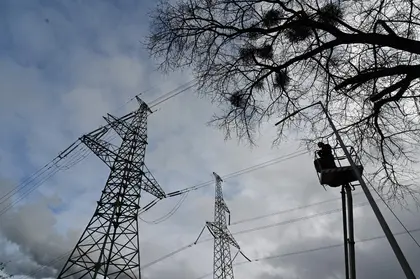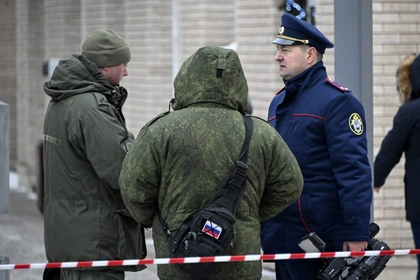Russia on Thursday 26 Jan. launched yet another wave of cruise missile and kamikaze drone strikes at Ukraine’s civilian power grid, killing eleven people but losing most of weapons to dense Ukrainian air defenses.
Power grid infrastructure damage was reported in four cities and authorities said repairs were in progress.
JOIN US ON TELEGRAM
Follow our coverage of the war on the @Kyivpost_official.
As in past attacks, Russian strike planners led off with an overnight wave of Iran-manufactured Shahed drones. Ukrainian defense officials have said Moscow uses slow-moving, push-propeller aircraft to seek out and attack Ukrainian air defenses.
- View the latest war in ukraine update in the Kyiv Post’s news stories released today.
- See the most recently published Ukraine news reports from today.
According to a statement by Ukraine’s Air Defense Command, at least 24 Shaheds, widely known as “flying mopeds” for their distinctive putt-putt engine sound, were shot down during the night Wednesday-Thursday. Fifteen were knocked down in skies over Kyiv, a statement from the Kyiv city administration said.
The main Moscow attack, a wave of bomber-launched cruise missiles launched after sunrise, started triggering air raid alarms across the country around 7 A.M. Maksym Marchenko, head of the Odesa regional defense command, said Russian warships in the Black Sea also launched missiles as well.
The Trukha Ukraina news channel said a secondary missile strike aimed specifically at the capital Kyiv was launched from Russia’s Belgorod Oblast’.
A Russian cruise missile that was shot down fell on a construction site killing one 55-year-old man and injured two people in a southern district of the capital Kyiv. In the southern city Zaporizhia an early morning strike killed three workers at a power station, the UNIAN news agency reported.

Poland to Use EU Presidency to Fast-Track Ukraine’s NATO and EU Membership
A follow-up Russian strike seemingly aimed at rescue workers clearing damage at the Zaporizhia site inflicted no more casualties, but caused additional damage, the report said.
Nationwide, eleven people died as a result of the attack, an afternoon statement from Ukraine’s Emergency Situations Ministry said.
On Thursday morning, explosions were reported in the vicinity of civilian infrastructure in Kyiv, Odesa, Vinitsiya, Lviv, Mykolaiv and Dnipro regions. Social media images showed a power substation burning in the Black Sea shore Odesa region near the village Usatove, and a fire near power infrastructure in the southern Zaporizhia region.
Authorities in Odesa said repair teams were on the scene but that electricity would be cut off to some sections of the city until damaged sections of the grid were fixed. Marchenko said the repairs would take “some time”. In Lviv, officials said no missiles hit anywhere and that reports of explosions were “faked”.
Multiple Kyiv Post reporters at separate locations in Kyiv heard an explosion at 10:06. Skies over the city were gray with low-lying clouds.
Kyiv Mayor Klitschko said in statements throughout the morning one missile detonated near a ground target in the riverside Dnipro district, damaging power infrastructure. He later said the city’s power grid “is functioning normally”. Ukrainian news media confirmed the strike took place and showed images of a crater in the ground.
By 11:15 Ukrainian air raid networks were reporting skies empty of Russian missiles, but that air attack was still possible because of a single Russian attack jet in air space over Belarus.
Putin’s missile bombardment campaign against Ukraine has mostly avoided using Belarusian sites and air space to launch strikes, however, even the take-off of a single Russian jet capable of carrying a missile, in Belarus, sets off air raid alerts across Ukraine, forcing civilians to seek bomb shelters. By 12:30 P.M. air raid warnings across Ukraine were canceled.
Valery Zaluzhny, commander of the Armed Forces of Ukraine (AFU), in an afternoon statement said that air defenders across the country shot down 47 of the 55 missiles launched by the Russians. Kremlin bomber aircraft flying in air space near the Sea of Azov, warships from Russia’s Black Sea Fleet, and unidentified launch platforms in Russia’s western Belgorod Oblast’ fired the weapons, Ukrainian news reports citing military sources said.
Ukraine’s air raid defense network was quick to transmit warnings across airwaves and social media channels before actual launches took place. According to an Interior Ministry Telegram statement, the first cruise missiles left the racks of a likely six Russian Tu-95 bombers in air space above Russia’s Rostov region, at 6:35 A.M.
Ukrainians across the country were glued to their smart phones as reports poured of three- and six-meter long Russian missiles boring into national air space. A flight of at least ten gray-painted missiles heading north along the Dnipro River was widely reported in social media, and video of one weapon in hurtling northward above the water at tree-top level was widely shared. Some information channels offered readers real-time maps of missile locations and probable flight directions.
AFU air defense units fired on incoming weapons in the Odesa, Dnipro and Cherkassy regions. A Kyiv Post reporter in the southern section of the capital heard anti-aircraft cannon firing, and later an explosion in the air possibly from a successful shoot down.
Ukrainian power grid operators switched of service in multiple regions in the missiles’ potential strike envelope, in a bid to prevent power surges following hits on generation facilities or substations. The decision left millions of homes and businesses. Power was restored to most locations in the capital by 2 P.M., Kyiv Post reporters at multiple locations in the city reported. At 4 P.M. the city’s power grid operator DTEK announced electricity supply network had returned to normal operations, but some planned blackouts might take place.
Russian President Vladimir Putin has called the destruction of Ukraine’s power grid a national war aim, with the objective of forcing the Ukrainian government and people to agree to the Russian army occupation of part of the country, and to agree to a total disarming of Ukraine’s military. Ukrainian public opinion towards Putin’s tactic has been overwhelmingly defiant.
The Kremlin bombing campaign launched in October at its peak hurled more than one hundred missiles at cities across Ukraine over the course of a few hours, putting some regions in total blackout for as much as three days. Falling supplies of multi-million-dollar cruise missiles, many manufactured with foreign-made components now under western sanctions, have forced Moscow planners to cut back on salvo size and frequency since late November.
You can also highlight the text and press Ctrl + Enter






